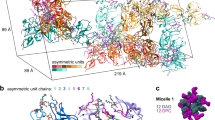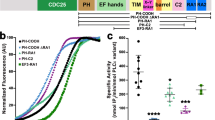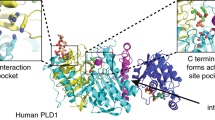Abstract
Although diverse signaling cascades require the coordinated regulation of heterotrimeric G proteins and small GTPases, these connections remain poorly understood. We present the crystal structure of the GTPase Rac1 bound to phospholipase C-β2 (PLC-β2), a classic effector of heterotrimeric G proteins. Rac1 engages the pleckstrin-homology (PH) domain of PLC-β2 to optimize its orientation for substrate membranes. Gβγ also engages the PH domain to activate PLC-β2, and these two activation events are compatible, leading to additive stimulation of phospholipase activity. In contrast to PLC-δ, the PH domain of PLC-β2 cannot bind phosphoinositides, eliminating this mode of regulation. The structure of the Rac1–PLC-β2 complex reveals determinants that dictate selectivity of PLC-β isozymes for Rac GTPases over other Rho-family GTPases, and substitutions within PLC-β2 abrogate its stimulation by Rac1 but not by Gβγ, allowing for functional dissection of this integral signaling node.
This is a preview of subscription content, access via your institution
Access options
Subscribe to this journal
Receive 12 print issues and online access
$189.00 per year
only $15.75 per issue
Buy this article
- Purchase on Springer Link
- Instant access to full article PDF
Prices may be subject to local taxes which are calculated during checkout




Similar content being viewed by others
References
Rhee, S.G. Regulation of phosphoinositide-specific phospholipase C. Annu. Rev. Biochem. 70, 281–312 (2001).
Harden, T.K. & Sondek, J. Regulation of phospholipase C isozymes by Ras superfamily GTPases. Annu. Rev. Pharmacol. Toxicol. 46, 355–379 (2006).
Singer, A.U., Waldo, G.L., Harden, T.K. & Sondek, J. A unique fold of phospholipase C-β mediates dimerization and interaction with Gαq. Nat. Struct. Biol. 9, 32–36 (2002).
Zhang, Y., Vogel, W.K., McCullar, J.S., Greenwood, J.A. & Filtz, T.M. Phospholipase C-β3 and -β1 form homodimers, but not heterodimers, through catalytic and carboxyl-terminal domains. Mol. Pharmacol. 70, 860–868 (2006).
Waldo, G.L., Boyer, J.L., Morris, A.J. & Harden, T.K. Purification of an AlF4− and G-protein βγ-subunit-regulated phospholipase C-activating protein. J. Biol. Chem. 266, 14217–14225 (1991).
Taylor, S.J., Chae, H.Z., Rhee, S.G. & Exton, J.H. Activation of the β1 isozyme of phospholipase C by α subunits of the Gq class of G proteins. Nature 350, 516–518 (1991).
Taylor, S.J. & Exton, J.H. Two α subunits of the Gq class of G proteins stimulate phosphoinositide phospholipase C-β1 activity. FEBS Lett. 286, 214–216 (1991).
Smrcka, A.V., Hepler, J.R., Brown, K.O. & Sternweis, P.C. Regulation of polyphosphoinositide-specific phospholipase C-β activity by purified Gq. Science 251, 804–807 (1991).
Smrcka, A.V. & Sternweis, P.C. Regulation of purified subtypes of phosphatidylinositol-specific phospholipase C β by G protein α and βγ subunits. J. Biol. Chem. 268, 9667–9674 (1993).
Boyer, J.L., Waldo, G.L. & Harden, T.K. βγ-subunit activation of G-protein-regulated phospholipase C. J. Biol. Chem. 267, 25451–25456 (1992).
Camps, M. et al. Stimulation of phospholipase C by guanine-nucleotide-binding protein βγ subunits. Eur. J. Biochem. 206, 821–831 (1992).
Park, D., Jhon, D.Y., Lee, C.W., Lee, K.H. & Rhee, S.G. Activation of phospholipase C isozymes by G protein βγ subunits. J. Biol. Chem. 268, 4573–4576 (1993).
Illenberger, D., Schwald, F. & Gierschik, P. Characterization and purification from bovine neutrophils of a soluble guanine-nucleotide-binding protein that mediates isozyme-specific stimulation of phospholipase C-β2. Eur. J. Biochem. 246, 71–77 (1997).
Illenberger, D. et al. Stimulation of phospholipase C-β2 by the Rho GTPases Cdc42Hs and Rac1. EMBO J. 17, 6241–6249 (1998).
Snyder, J.T., Singer, A.U., Wing, M.R., Harden, T.K. & Sondek, J. The pleckstrin homology domain of phospholipase C-β2 as an effector site for Rac. J. Biol. Chem. 278, 21099–21104 (2003).
Illenberger, D., Walliser, C., Nurnberg, B., Diaz Lorente, M. & Gierschik, P. Specificity and structural requirements of phospholipase C-β stimulation by Rho GTPases versus G protein βγ dimers. J. Biol. Chem. 278, 3006–3014 (2003).
Essen, L.O., Perisic, O., Cheung, R., Katan, M. & Williams, R.L. Crystal structure of a mammalian phosphoinositide-specific phospholipase C-δ. Nature 380, 595–602 (1996).
Hemsath, L., Dvorsky, R., Fiegen, D., Carlier, M.F. & Ahmadian, M.R. An electrostatic steering mechanism of Cdc42 recognition by Wiskott-Aldrich syndrome proteins. Mol. Cell 20, 313–324 (2005).
Carstanjen, D. et al. Rac2 regulates neutrophil chemotaxis, superoxide production, and myeloid colony formation through multiple distinct effector pathways. J. Immunol. 174, 4613–4620 (2005).
Keller, P.J., Gable, C.M., Wing, M.R. & Cox, A.D. Rac3-mediated transformation requires multiple effector pathways. Cancer Res. 65, 9883–9890 (2005).
Dvorsky, R. & Ahmadian, M.R. Always look on the bright site of Rho: structural implications for a conserved intermolecular interface. EMBO Rep. 5, 1130–1136 (2004).
Ferguson, K.M., Lemmon, M.A., Schlessinger, J. & Sigler, P.B. Structure of the high affinity complex of inositol trisphosphate with a phospholipase C pleckstrin homology domain. Cell 83, 1037–1046 (1995).
Garcia, P. et al. The pleckstrin homology domain of phospholipase C-δ1 binds with high affinity to phosphatidylinositol 4,5-bisphosphate in bilayer membranes. Biochemistry 34, 16228–16234 (1995).
Runnels, L.W., Jenco, J., Morris, A. & Scarlata, S. Membrane binding of phospholipases C-β1 and C-β2 is independent of phosphatidylinositol 4,5-bisphosphate and the α and βγ subunits of G proteins. Biochemistry 35, 16824–16832 (1996).
Singh, S.M. & Murray, D. Molecular modeling of the membrane targeting of phospholipase C pleckstrin homology domains. Protein Sci. 12, 1934–1953 (2003).
Wang, T., Dowal, L., El-Maghrabi, M.R., Rebecchi, M. & Scarlata, S. The pleckstrin homology domain of phospholipase C-β2 links the binding of Gβγ to activation of the catalytic core. J. Biol. Chem. 275, 7466–7469 (2000).
Lemmon, M.A. Pleckstrin homology domains: not just for phosphoinositides. Biochem. Soc. Trans. 32, 707–711 (2004).
Abdul-Manan, N. et al. Structure of Cdc42 in complex with the GTPase-binding domain of the 'Wiskott-Aldrich syndrome' protein. Nature 399, 379–383 (1999).
Mott, H.R. et al. Structure of the small G protein Cdc42 bound to the GTPase-binding domain of ACK. Nature 399, 384–388 (1999).
Morreale, A. et al. Structure of Cdc42 bound to the GTPase binding domain of PAK. Nat. Struct. Biol. 7, 384–388 (2000).
Garrard, S.M. et al. Structure of Cdc42 in a complex with the GTPase-binding domain of the cell polarity protein, Par6. EMBO J. 22, 1125–1133 (2003).
Worthylake, D.K., Rossman, K.L. & Sondek, J. Crystal structure of Rac1 in complex with the guanine nucleotide exchange region of Tiam1. Nature 408, 682–688 (2000).
Navaza, J. Implementation of molecular replacement in AMoRe. Acta Crystallogr. D Biol. Crystallogr. 57, 1367–1372 (2001).
Hirshberg, M., Stockley, R.W., Dodson, G. & Webb, M.R. The crystal structure of human RAC1, a member of the Rho-family complexed with a GTP analogue. Nat. Struct. Biol. 4, 147–152 (1997).
Schneider, T.R. & Sheldrick, G.M. Substructure solution with SHELXD. Acta Crystallogr. D Biol. Crystallogr. 58, 1772–1779 (2002).
Potterton, E., McNicholas, S., Krissinel, E., Cowtan, K. & Noble, M. The CCP4 molecular-graphics project. Acta Crystallogr. D Biol. Crystallogr. 58, 1955–1957 (2002).
Jones, T.A., Zou, J.Y., Cowan, S.W. & Kjeldgaard, M. Improved methods for building protein models in electron density maps and the location of errors in these models. Acta Crystallogr. A 47, 110–119 (1991).
Brunger, A.T. et al. Crystallography & NMR system: a new software suite for macromolecular structure determination. Acta Crystallogr. D Biol. Crystallogr. 54, 905–921 (1998).
Christopher, J.A. SPOCK: The Structural Properties Observation and Calculation Kit (The Center for Macromolecular Design, College Station, Texas, USA, 1998).
Bourdon, D.M., Wing, M.R., Edwards, E.B., Sondek, J. & Harden, T.K. Quantification of isozyme-specific activation of phospholipase C-β2 by Rac GTPases and phospholipase C-εby Rho GTPases in an intact cell assay system. Methods Enzymol. 406, 489–499 (2006).
Acknowledgements
We thank S. Hicks for her valuable work on the apo structure of PLC-β2. This work was funded by the US National Institutes of Health (GM 057391).
Author information
Authors and Affiliations
Contributions
M.R.J., T.K.H. and J.S. conceived, analyzed and performed experiments and cowrote the manuscript. J.T.S. and S.G. assisted with construct design. J.T.S. and D.K.W. assisted with X-ray data collection and phasing.
Corresponding author
Ethics declarations
Competing interests
The authors declare no competing financial interests.
Supplementary information
Supplementary Fig. 1
Schematic of PH domain regulation. (PDF 8150 kb)
Supplementary Fig. 2
Sequence alignments of Rho GTPases and phospholipase C isozymes. (PDF 227 kb)
Rights and permissions
About this article
Cite this article
Jezyk, M., Snyder, J., Gershberg, S. et al. Crystal structure of Rac1 bound to its effector phospholipase C-β2. Nat Struct Mol Biol 13, 1135–1140 (2006). https://doi.org/10.1038/nsmb1175
Received:
Accepted:
Published:
Issue Date:
DOI: https://doi.org/10.1038/nsmb1175
This article is cited by
-
Structure of phospholipase Cε reveals an integrated RA1 domain and previously unidentified regulatory elements
Communications Biology (2020)
-
ROCK1 is a novel Rac1 effector to regulate tubular endocytic membrane formation during clathrin-independent endocytosis
Scientific Reports (2017)
-
Full-length Gαq–phospholipase C-β3 structure reveals interfaces of the C-terminal coiled-coil domain
Nature Structural & Molecular Biology (2013)
-
Immune regulation by phospholipase C-β isoforms
Immunologic Research (2013)



